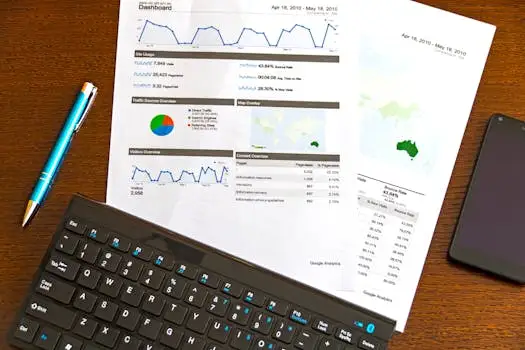
Step-by-step explanation of basic functions and reports for effective digital marketing
Google Analytics is one of the most popular tools for monitoring and analyzing website traffic. It offers valuable information about who visits your site, what content they view, and how they got there. It is free to use from Google, as long as your website does not exceed the 10 million visits per month.
The Google Analytics is an essential tool for those involved in marketing, especially digital marketers, as it provides detailed data on site performance, advertising campaigns, audience characteristics, and other elements that contribute to improving overall performance.
For businesses that wish to grow online, leveraging the Google Analytics helps to draw safe conclusions about the profitability of investments and actions they take on the internet.
One of the most important problems encountered by Digital Marketers today is that many business people have difficulty understanding even the basic references of Google Analytics.
Basic tabs in Google Analytics
To begin, we will get to know the basic tabs located in the left column of Google Analytics, except for “Customization” which is aimed at advanced users.
Home Page: By logging in to Google Analytics, you are taken to the Home Page, which presents a summary of your site's basic statistics: total visits over a specific period of time, active users at that time, traffic sources, geographic regions of users, and other basic statistics. This page provides an immediate view of your site's performance.
Google Analytics Reports: Categories & Functions
The Reports in Google Analytics are divided into five main categories:
1. In real time / Real Time
2. Audience
3. Acquisition
4. Behavior
5. Conversions
Each category includes subsections with specialized reports that offer in-depth data analysis. Below are the key features of each category to help you find the data you need more easily.
Real Time: Instant activity monitoring
The unit “In real time” displays data as it happens. You can see how many users are currently on your site, what pages or articles they are reading, what countries they are from, how they got to your website, and what keywords they used in their search. GoogleUsually the data covers the latest 5 minutes, while in some cases they reach up to 30 minutes.
– Locations:
Here you can see which countries or regions your current visitors come from and how long they stay on your website.
– Traffic Sources:
This report shows how users found your site — e.g. through social media or by typing the address directly.
– Content:
You track which pages visitors are currently on, the title, URL, and the percentage of active users per page.
– Events:
It records custom interactions like ad clicks, file downloads, or video views in real time.
– Conversions:
It shows whether the goals you set are being completed — for example, placing an order or filling out a contact form.
Audience: Know the profile of your visitors
The “Audience” section provides important data about site visitors: demographic characteristics, interests, geographic distribution, and more. This information helps improve targeting of specific audience groups.
– Active Users:
Tracks users who have visited the site in the last 1, 7, 14, or 30 days — ideal for measuring engagement.
– Life Time Value:
It calculates the long-term value of users acquired through various actions such as Google Ads or email marketing.
– Cohort Analysis:
It separates groups of users with common characteristics (e.g. those who registered on a specific day) and monitors their behavior.
– Audience Types:
Create custom audience segments (up to 20 at a time) and apply them to other analytics reports.
– User Explorer:
It analyzes the behavior of individual users, not groups — ideal for seeing what drove a particular action or purchase.
– Demographics:
Shows age and gender of users; e.g., average time spent by men aged 35-44.
– Interests:
Displays user interest categories such as technology or fashion — requires enabling remarketing features in Google Analytics.
– Geographic Criteria (Geo):
It offers data on the location and language of visitors.
– Behavior:
It evaluates whether new users return to the site and their engagement (new/returning, frequency of visit, etc.).
– Technology:
It shows which browser and operating system users are using as well as the internet connection provider.
– Mobile:
It analyzes whether visits come from desktop, mobile, or tablet — even the device model.
– Customization:
It allows you to compare user segments based on your own criteria or variables.
– Comparative Evaluation (Benchmarking):
Compare your own data with aggregated data from other industry sites to identify missed opportunities.
– Users Flow:
It visualizes the user journey through the site based on variables such as country or social network.
Acquisition: How do users get to your site?
“Acquisition” reports show which channels traffic comes from: organic search, social media, email marketing, etc., but also what users do after entering the site.
– Total Traffic (All Traffic):
It records which channels bring in more users and which ones perform better in terms of engagement or conversions.
– Google Ads:
Once you've linked your account to Google Ads, you can see which campaigns are performing best.
– Search Console:
Shows the site's performance in Google's organic results — requires connecting Search Console to your Google Analytics account.
– Social Networks (Social):
It presents data on traffic through social media platforms and the effectiveness of each channel.
– Campaigns:
Analyzes the performance of advertising campaigns from various sources such as Google Ads, Facebook Ads or SEO campaigns.
Behavior: What do users do on the site?
“Behavior” reports provide data on user actions: what content they view, how quickly the site loads, what they search for in the internal search engine, etc. This information helps identify areas for improvement in the operation of your website.
– Behavior Flow Diagram:
It visualizes the user journey per landing page so you can evaluate whether they are being led to the desired goals.
– Site Content:
Provides engagement metrics per page: views, dwell time, bounce rates, etc., for all pages, catalogs or landing pages.
– Site Speed:
Provides information on content loading time per device — critical for mobile optimization.
– Site Search:
It shows what terms users are searching for in the site's internal search engine — valuable insight into what your audience is really interested in.
– Events:
It records specific interactions such as filling out a form or downloading a pdf/video file, etc.
– Publisher:
For those with Google advertising spaces connected to AdSense or Ad Exchange — displays data about ad revenue on your site.
* The “Experiments” report has now been replaced by Google Optimize for more advanced A/B testing.
Conversions: Measure the effectiveness of your website
The last category of reports concerns conversions: how effective is the website in achieving goals such as product purchases or completion of registration/contact forms?
– Objectives:
- It shows progress towards goals you have set — e.g., filling out a registration form or downloading a file. Proper goal setup in Google Analytics settings is essential.
- If you don't know how to set goals, ask your website development company or digital marketer for help.
– E-Commerce:
- Records e-shop transaction data: sales by product/category,
purchasing behavior,
product performance,
sales & product lists. - It is necessary to add special e-commerce code to the e-shop so that the data is displayed correctly.
– Multichannel Channels:
- It depicts the user journey between different channels before completing a purchase or other conversion.
- And here, special e-commerce integration code is required.
Continuous development & training in Google Analytics
OR Google constantly enriches the Google Analytics with new features to provide the most targeted data possible for analyzing a website's performance. If you wish to delve further into the tool's functions, you can take free online courses at Google's Analytics Academy at the following link: https://analytics.google.com/analytics/academy/ (*Courses are offered in English.)



 +30 6943 755057
+30 6943 755057 Ilioupoli, Athens
Ilioupoli, Athens